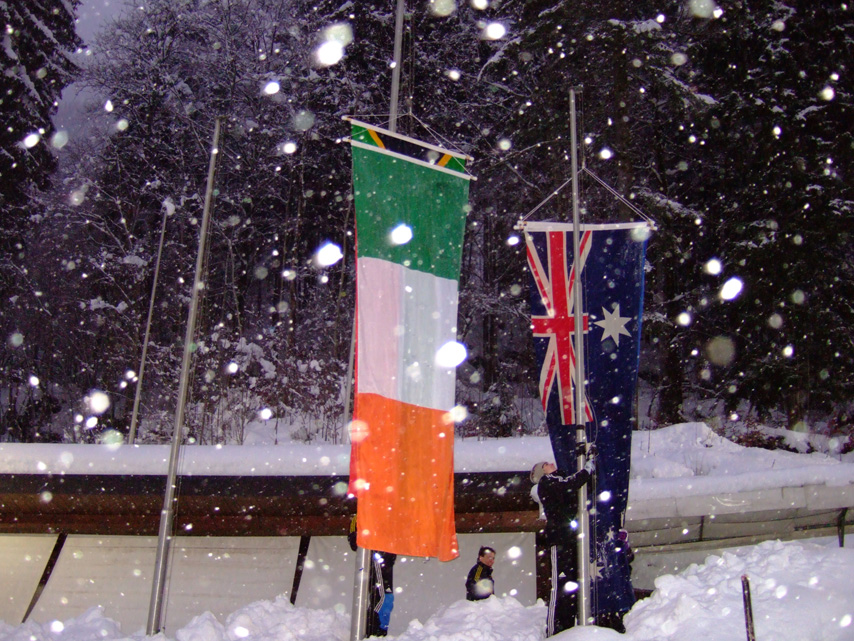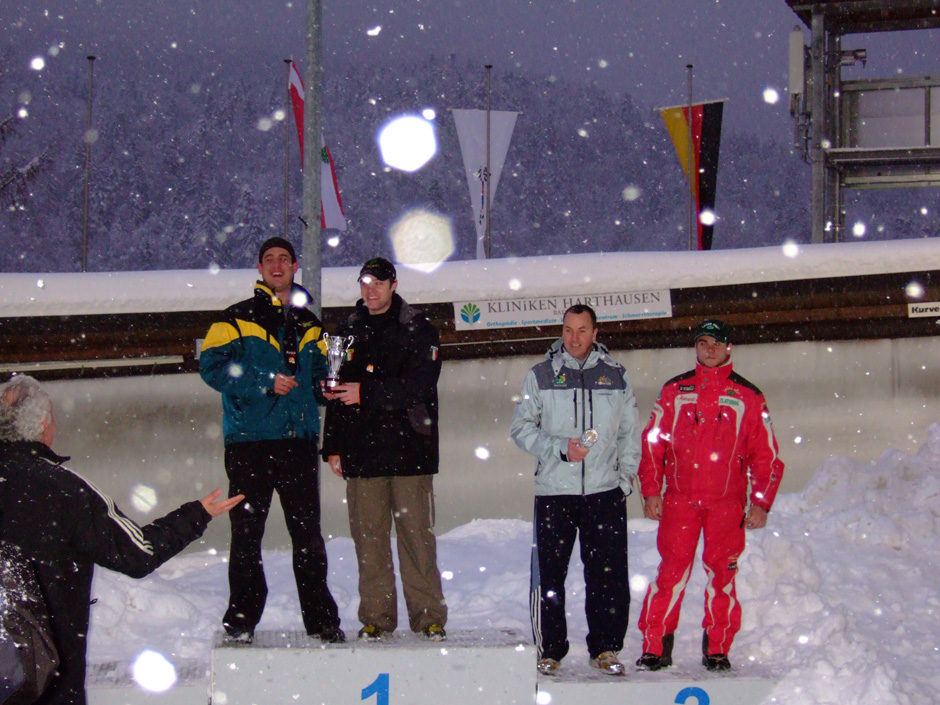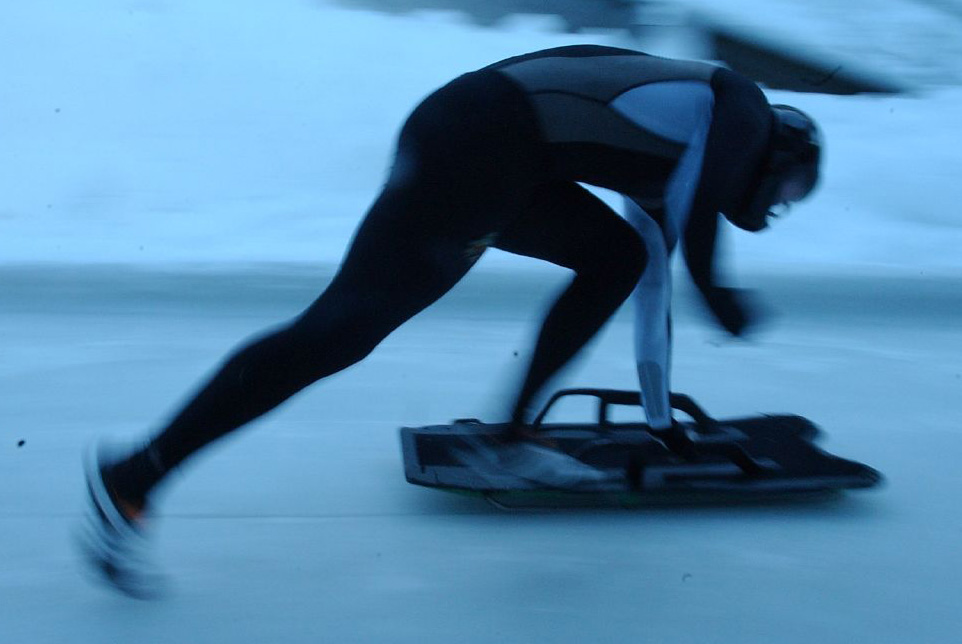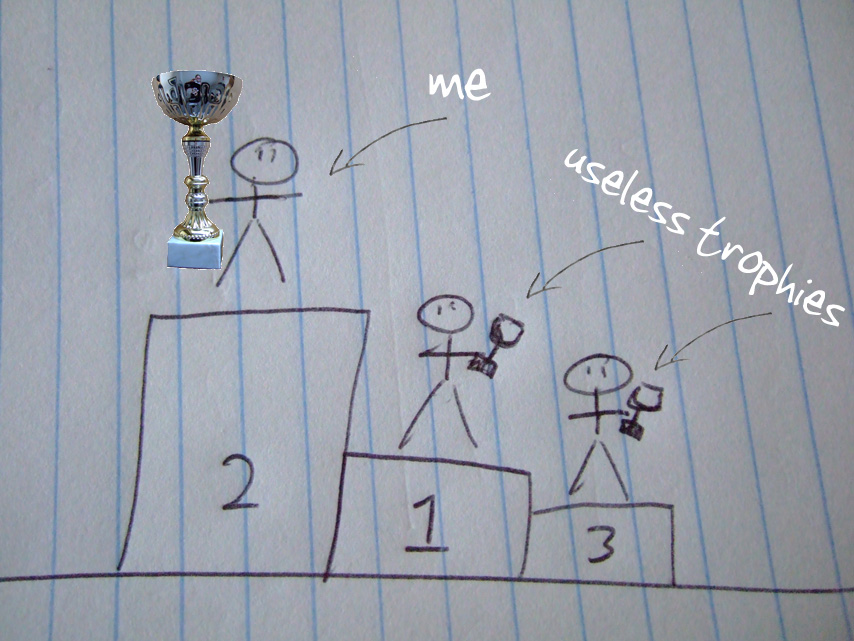National Anthem
 As you may recall in my explanations of Olympic qualification, I needed to finish in the top 8 of the Challenge Cup. So, just to make sure, I went ahead and won the whole thing. Better safe than sorry, you see. To be more specific I came joint first but that's a minor detail that doesn't preclude the fact that I've qualified for the Olympics. After all the preparation and after doing so well in training I was terrified that I wouldn't be able to do it on race day. How wrong was I. Instead I pushed faster than I'd ever pushed and slid faster than I'd ever done before. Everything came together, I almost forgot that it was an Olympic qualifier, all I wanted to do was go so fast I'd destroy every other athlete. I was quiet and smooth on the sled, correcting mistakes almost before they'd even happened. I can't describe what it feels like to think and slide that fast, I don't think I'll ever forget it.
As you may recall in my explanations of Olympic qualification, I needed to finish in the top 8 of the Challenge Cup. So, just to make sure, I went ahead and won the whole thing. Better safe than sorry, you see. To be more specific I came joint first but that's a minor detail that doesn't preclude the fact that I've qualified for the Olympics. After all the preparation and after doing so well in training I was terrified that I wouldn't be able to do it on race day. How wrong was I. Instead I pushed faster than I'd ever pushed and slid faster than I'd ever done before. Everything came together, I almost forgot that it was an Olympic qualifier, all I wanted to do was go so fast I'd destroy every other athlete. I was quiet and smooth on the sled, correcting mistakes almost before they'd even happened. I can't describe what it feels like to think and slide that fast, I don't think I'll ever forget it.
I took 5 hundredths off my push time and half a second off my downtime with a 49.47s. No-one else even got below 50 seconds. By the time the two heats of the first race were done, I'd finished over a second clear of everyone else. When races are normally won by tenths, that's devastating.
The second race was plagued by snow. I hate sliding in snow, it makes things a bit of a lottery. Generally the better sliders will be faster but occasionally novices can get caught in clear lines and get a fast time. And even the good sliders can get caught by snow drifts building up in the track. I was in the lead after the first heat which means I go off last in the second heat. With about 3 people to go, a blizzard descended and the roulette wheel was set spinning. On the way down I was steering for clear patches of track but it wasn't good enough and I dropped to third place. Annoying, but inconsequential, I'd done enough to finish joint first and earn my place in the Olympics.  My first ever podium was very enjoyable. Only a few weeks before we'd been joking that they'd have a hard time getting hold of the Irish National Anthem if we ever won anything, but they surprised us and got an accurate version of it, although it definitely the slowest version I've ever heard. I was sharing the podium with Tyler and after all the training we've done together I can't think of a more fitting result.
My first ever podium was very enjoyable. Only a few weeks before we'd been joking that they'd have a hard time getting hold of the Irish National Anthem if we ever won anything, but they surprised us and got an accurate version of it, although it definitely the slowest version I've ever heard. I was sharing the podium with Tyler and after all the training we've done together I can't think of a more fitting result.
Calm Before the Storm
 It's 8:30am, Race Day. I've just had a good night's sleep and woken up with a few butterflys in my stomach (I thought that tortellini tasted strange last night...). For reasons unknown, someone tried to call me at half one in the morning. Fortunately for me I had my phone on silent so their diabolical plans of sleep-deprivation failed.I have spent the past few days doing pretty much the best preparation possible. Paying particular attention to sleeping well, eating correctly, stretching etc...
It's 8:30am, Race Day. I've just had a good night's sleep and woken up with a few butterflys in my stomach (I thought that tortellini tasted strange last night...). For reasons unknown, someone tried to call me at half one in the morning. Fortunately for me I had my phone on silent so their diabolical plans of sleep-deprivation failed.I have spent the past few days doing pretty much the best preparation possible. Paying particular attention to sleeping well, eating correctly, stretching etc...
Official training has gone brilliantly, I brought my personal best yesterday down to 49.97s and have probably been the most consistent slider.
It's looking good but training doesn't mean anything, only the races matter. I've got to keep that pedal to the floor and, as my pal Loc says, push that NOS button when it's time to shine.
Storm's a comin'.
That Which is Measured, Improves
I first encountered the phrase "That which is measured, improves" while working as an intern in Sun Microsystems. There we were benchmarking the Solaris operating system. If something dropped in performance we could work to pin-point it and remedy the situation. That way we ensured that the OS kept getting better with every iteration. The same process is applied to sports. People always find a way to quantify their performance. A weightlifter has a maximum weight that they've lifted. A sprinter has a best time over 100m. A golfer has their farthest drive. These measurements are the current limit that have been encountered. They set a boundary on what you know you should be able to do again because if you've done it once, you can do it again.
The same process is applied to sports. People always find a way to quantify their performance. A weightlifter has a maximum weight that they've lifted. A sprinter has a best time over 100m. A golfer has their farthest drive. These measurements are the current limit that have been encountered. They set a boundary on what you know you should be able to do again because if you've done it once, you can do it again.
The ultimate aim of this is to push the boundary out again and again until it's further out than anyone else has ever been. Lift heavier, run faster, drive the ball further, slide faster. It's not always possible or realistic to break world records.
I'm a sprinter, but I doubt I'll ever get below ten seconds for the 100m. What that means is that I have to instead look at my own boundaries. I may not ever break the world record but I still relish the feeling of breaking my own personal best.
I've just come from training on the Igls track in Austria. My best time on the track for the last two years has been 55.32 seconds. Yesterday afternoon I took that down to 55.03s.
I wasn't really expecting it but in hindsight it's probably the best thing that could have happened to me. It's a real confirmation that I'm sliding better than I ever have. This confidence is the best way to be going into the most important competition of my life. Official training for the competition starts tomorrow. Five days til I D-Day.
Incidentally, above is a picture of what a one-handed start looks like.
My Heroes
 When I hear the word hero, my immediate reaction is to think of a super-man like figure. Mercurial, strong, infallible. Rubbish. When I think about it some more, I realise some of the greatest heroes didn’t necessarily succeed. I’m going to tell you about two of them.
When I hear the word hero, my immediate reaction is to think of a super-man like figure. Mercurial, strong, infallible. Rubbish. When I think about it some more, I realise some of the greatest heroes didn’t necessarily succeed. I’m going to tell you about two of them.
Ireland has a women’s bobsled team made up of two sisters, Siobhain and Aoife Hoey. They are extraordinarily talented athletes and have been so all their lives. They originally came from track and field, winning many national titles and holding various records along the way. I’ve seen large boxes overflowing with medals and trophies. And they are just the one’s they bothered bringing down from the attic. They didn’t just get there by gifted genetics, they worked hard for it.
Over the past eight years Siobhain has been involved in bobsled, representing Ireland in the brakewoman position. That’s the person at the back providing the main push when starting a bobsled. More recently Aoife has joined her as a driver. I don’t need to explain that one.
Through this, Siobhain has managed to juggle working as a teacher and being one of the best brakewomen in the world. She is also the Treasurer of the Irish Bobsled and Skeleton Association, as well as the person who got me involved in Skeleton.
Top-level sport is quite difficult. I don’t believe many people actually think about the work that goes on behind the scenes. The thousands and thousands of hours of preparation and training that are needed to compete on an international level. Support is a very important part of this preparation. An athlete needs to be able to concentrate on doing exactly what they need to do in order to win. Imagine how long it would take to fly anywhere in an aeroplane if the pilot had to check everyone’s luggage, load it on the plane, issue tickets, fill the plane with fuel, make sure all the other planes were cleared out of the way for takeoff, then actually fly the damn thing.
In an ideal world, Siobhain and Aoife would be able to concentrate on their training. If one got injured, she would have physio on hand to get her fixed up asap. They wouldn’t have to worry about booking flights, accommodation, entering competitions, insurance, arranging sled transport, van rental. They would have a team manager to organise all of that. The sled and its steel runners would be cared for and maintained perfectly by a sled technician. They would have a dedicated speed and strength coach to ensure that they are strong and fast in the crucial push start. They would have a track coach to teach Aoife how to steer the sled through the fastest lines down the track. They would have a good sled provided for them. They would have the support of a well-funded national organisation.
Instead, they must do all this by themselves. And when they’re done, they must try to compete against nations that live in an ideal world. And compete they did, against all the odds. They bought a new sled for this season. Paid the E10,000 out of their own pocket, despite promises of support from certain organisations that then later feigned ignorance. The sled was late being made, and turned out to be slower than their older one. During transport to a training week in Europe, it went missing for a few days, making them miss the training. During push training in Canada, Siobhain cut her ankle on the runners, requiring minor surgery and slowing down her push. Aoife has to make do with a shared small-nations coach and she still drives better than half the other nations on the World Cup circuit. Despite remaining drug-free they compete against women that are so manly, their beard growth is matched only by their girlfriend’s and their legs are thicker than most rugby players I’ve seen. And still they compete.
You might remember my explanation of how World Cup skeleton athletes accumulate points by winning races and how the top nations get to go to the Olympics. It’s the same for bobsled. Last night Siobhain and Aoife competed in the last World Cup race for Olympics qualifying. They were so close, only one place away from being able to walk into the Olympic stadium to represent their country. The single greatest honour an athlete can ever have. They didn’t make it.
I was there to watch and help with the sled. They knew as soon as the run was finished that it wasn’t good enough. The push wasn’t quite fast enough, the drive not quite quick enough. It was over. I could only watch helplessly as the adrenaline wore off them to make way for the inevitable realisation that they had not made it to the Olympics. Slowly the tears came and there was nothing else to do. They had given everything, strained every last muscle and sinew, given every last penny, sweated every last drop of blood, and it still hadn’t been enough.
But had they failed? There is a qualitative difference between someone who nearly climbs to the top of Mount Everest and someone who reads about it in a book. Just because they didn’t make it to the very top doesn’t mean they didn’t climb the other 8000 metres. A good friend of mine recently told me that people are defined by what they achieve, not what they don’t. Just because Siobhain and Aoife didn’t qualify for the Olympics doesn’t alter the fact that they are amongst the best athletes in the world. It doesn’t erase all those competitions where they represented Ireland. It doesn’t make all the friends they made on the way disappear. What’s more, their achievements are all the more spectacular because they did it by themselves with hardly any help from anyone. If anyone should to be in the Olympic stadium carrying the Irish flag, it’s them. When I’m there I’ll imagine they’re walking beside me, where they deserve to be in an ideal world.
Shenanigans
 Ignore this post if you don’t like rants. After the competition in Austria it was a quick blast on the Autobahn up to Konigssee for a bit of push training. Push training is just done on a small 80m track behind the track proper. As the name indicates, it's just training for the push at the start of a run. The track proper is extremely busy at the moment. There was the Luge world cup there last week, the Bavarian Championships today and the Bobsled and skeleton world cup all next week. As soon as that's finished there's the Challenge Cup (my Olympic qualifier). As I said, the track is super busy. No extra sliding time available for anyone.
Ignore this post if you don’t like rants. After the competition in Austria it was a quick blast on the Autobahn up to Konigssee for a bit of push training. Push training is just done on a small 80m track behind the track proper. As the name indicates, it's just training for the push at the start of a run. The track proper is extremely busy at the moment. There was the Luge world cup there last week, the Bavarian Championships today and the Bobsled and skeleton world cup all next week. As soon as that's finished there's the Challenge Cup (my Olympic qualifier). As I said, the track is super busy. No extra sliding time available for anyone.
Or so we thought.
Somehow certain people have managed to get extra training time. In little half hour slots after each world cup session for the next week. That's quite a bit of extra practice on a track that will get you into the Olympics if you're good enough on it. It seems that nearly every week I read stories about some student or other getting in trouble about posting comments about teachers or fellow students. I'm not sure what the ramifications of this are for me, but as a member of the Irish skeleton team I suppose I should show some decorum. Consequently I'm not going to name names. I'm just going to assign initials at random. At Random.
So, Mr A and Mr G are enjoying their training and gradually getting better at this oh-so-important track. Which is great. I don't have a problem with people putting effort in, working hard and reaping the rewards. What I do have a problem with is when other people are denied the opportunity to put the effort in, work hard and reap their own rewards. While Mr's A and G are happily sliding away, there are several other people who have been told that they can't slide on the track.
Does that sound a little unfair to you? It sure does to me. And this is just icing on the cake. Some background info needed here. Tyler, the South African we train with, needs to do three competitions on three separate tracks in order to compete in the Challenge Cup. He already had two tracks done, but was left without the third when the competition in Altenberg was cancelled due to adverse weather conditions in the form of tons and tons and tons of snowfall. Tyler was entered in the race, was there for the little competition training that wasn’t cancelled and possibly could have done quite well in the race. So it would be a bit unfair to exclude him from the Challenge Cup simply because there was too much snow at another competition. The FIBT, following a precedent already set a couple of years ago, have officially credited him with the race so that he may compete in the Challenge Cup. It’s important to note that Tyler still needs to qualify to the Olympics through the Challenge Cup. He hasn’t been handed anything on a platter, only the chance to compete fairly. More background info. Tyler is an extraordinarily talented slider. I will be genuinely shocked if he doesn’t finish in the top 8 in the Challenge Cup. Now imagine, if you can, that Tyler wasn’t competing in the Challenge Cup. That means he wouldn’t be taking up one of the qualifying places. In turn that means someone in 9th place would be able to qualify. Well, would you be at all surprised if I told you that someone in that very position is objecting to the FIBT crediting people with the race in Altenberg. I’ve even heard that someone is going as far as to take the issue to some arbitration court. Interestingly it’s also the same person who has managed to get extra training on the Konigssee track, while excluding others who also need it. I don’t believe for one second that the FIBT will back down on their decision. It’s the only fair decision.
As I said, I’m not going to name names. I don’t have to. You will be able to see the name for yourself. Just go to www.fibt.com later this month. Have a look at the results for the Challenge Cup. If there is any justice in the world you will see the name just outside qualification for the Olympics. Preferably by as small a time margin as possible to make the justice even sweeter.
Let this be a lesson to anyone looking to get involved in sport at international and Olympic levels. When the stakes are this high, people show their true colours and will screw each other over at the drop of a hat.
Challenge Cup


What do you guys think of the new logo I half came up with for our team? I’ll have to change it a bit to avoid getting sued to death by the company that came up with the tshirt that gave me the idea. There’s a photo of the tshirt below it.
Anyway, in an effort to make my posts more reader-friendly, I’m attempting to make things a bit shorter. In this snippet I’m going to explain how I qualify for the Olympics. It’s done through the Challenge Cup, a competition which takes place this year in Konigssee, Germany.
Here's how the Challenge Cup works. In the world of skeleton there are two levels of competition.
First is the World Cup, which tends to be populated with the larger nations like USA, Canada, Germany, Austria, UK etc. Think of it as the Premier League.
Second is the Europa and America's Cups which is like the First Division. It's for all the small nations people, like Ireland, Slovakia, Brazil, Lebanon, Bermuda etc.
During the season the World Cup nations do their competitions and accumulate points depending on how well they do. They are ranked according to these points. The top 12 nations get to send people to the Olypmics so they're happy.
The other 4 nations aren't happy because they have to come down to the Challenge Cup and compete with the riff raff smaller nations. Just like relegation in football. In the Challenge Cup the top 8 individuals get to go to the Olympics. These places must be filled with 8 different nations. So, if the top 8 individuals are from different nations they all get to go. If, for example, there are two Irishmen in the top 8, only one of us gets to go to the Olympics, and whoever is in 9th place then qualifies.
Last year, I was only one place outside of qualification. I’m sliding over a second quicker this time round. The others have improved, but not that much. I just have to do it on race day, 12 days away.
A Pleasant Surprise
 Well, happy new year to everyone who bothers looking at this blog. Haven't put up a post for a while, I was extremely busy over Christmas, eating and sleeping. Had to be done.
Well, happy new year to everyone who bothers looking at this blog. Haven't put up a post for a while, I was extremely busy over Christmas, eating and sleeping. Had to be done.
To bring you up to speed: During the training week in Konigssee, just before Christmas, I continued to improve and brought my best time on the track down to 49.99 seconds. That's really really fast. Admittedly the ice was quite quick that day, but it shows I was able to put it to good use. If I can keep sliding like this on race day, I think I'll make it to the Olympics, which would be nice.
After a short week home, I flew out at 7:10am on New Years day to Austria to resume training. We were just there for a few days but we managed to pack it in. Forerunning for the British Championships, then taking part in the Austrian Championships. I came second in the guest class of the Austrian Champs and netted a rather nice trophy. We weren't expecting any medals or anything, maybe a mars bar and a pat on the back. Then after they'd given the natives their medals they hauled us up and gave us trophies. Sweet.
I didn't have my camera on me at the time so I've drawn what I believe to be an accurate representation of what the ceremony looked like.









